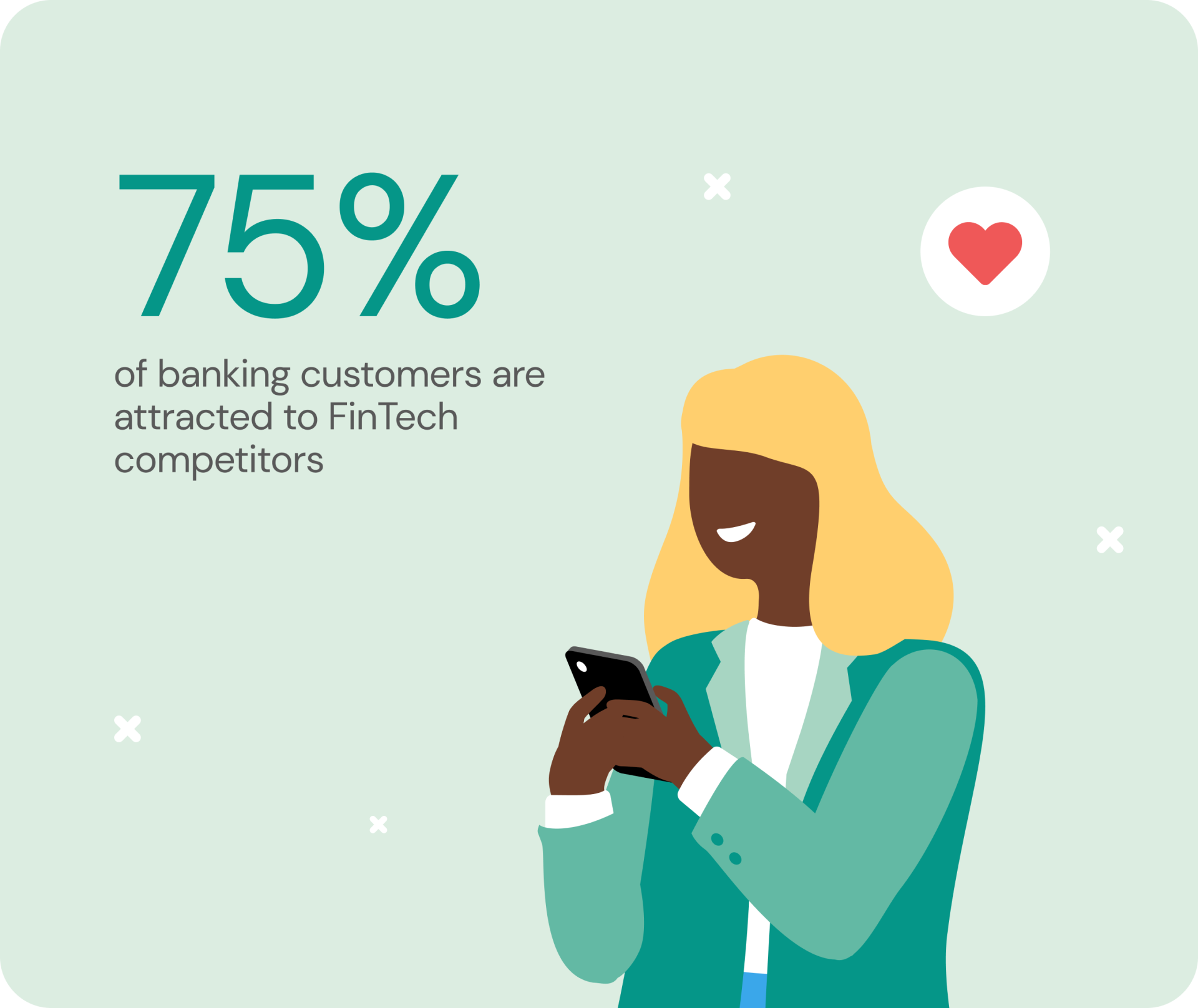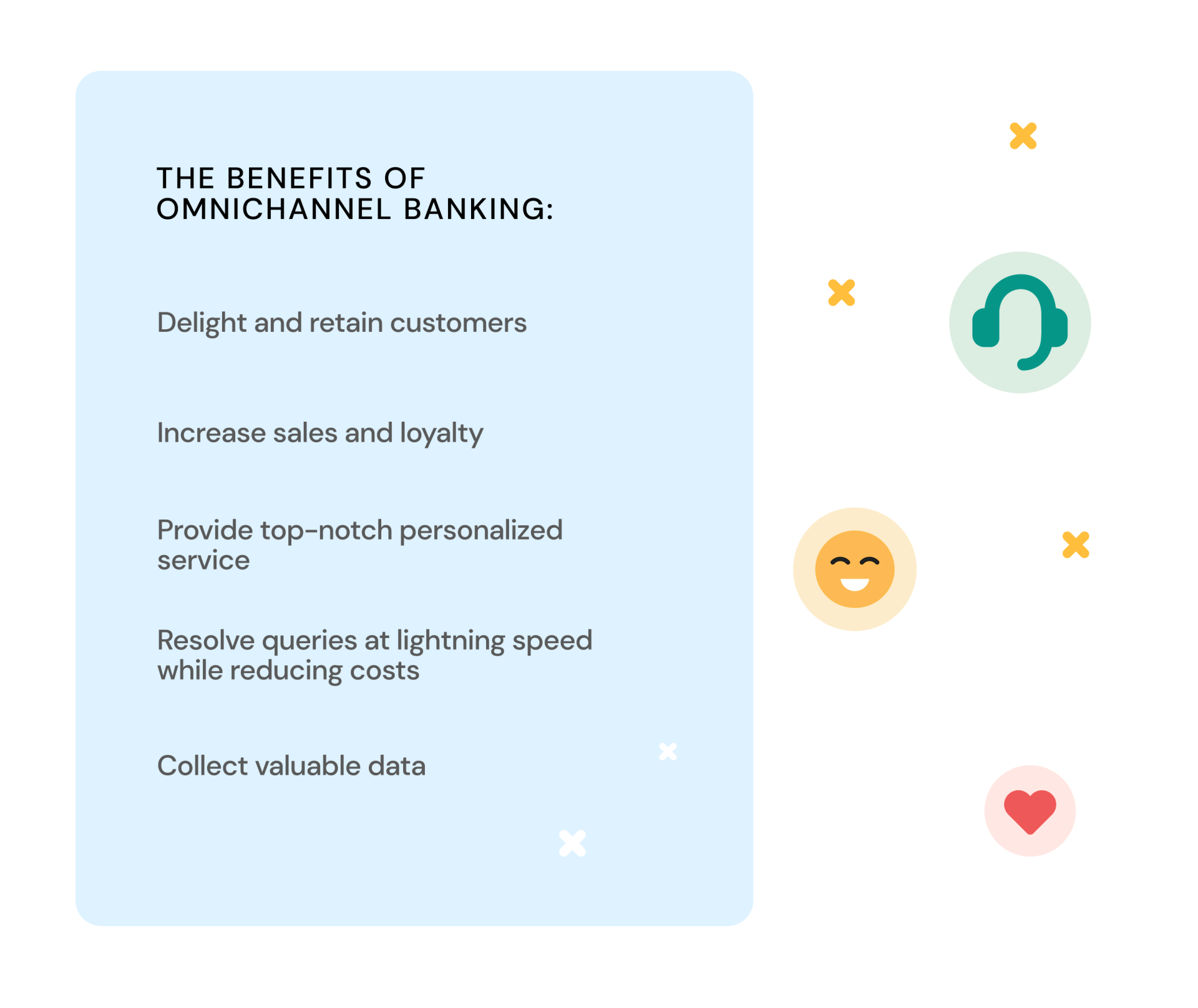Today’s consumers demand more flexibility and convenience than ever before when it comes to banking. Throughout their journey with a bank, they’ll use many channels and expect their experience to be seamless, whether they’re visiting in branch, using mobile banking or an ATM, talking to a representative over the phone or a messaging app, chatting with a virtual assistant, or emailing their advisor.
Research from Capgemini found that about 75% of banking customers are attracted to FinTech competitors. Why? Because they offer the kind of products and experiences customers expect — fast, convenient, and cost-effective.
Combining the best of digital and physical touchpoints to deliver seamless, personalized service is key in securing lasting customer relationships, but many financial institutions are still struggling to make omnichannel banking a reality.

When 75% of banking customers are attracted to FinTech competitors, it's clear that customers expect fast, convenient experiences.
In this blog post, we examine the role of omnichannel in today’s banking landscape and how technology like cloud-based omnichannel contact centers can help you meet customers’ demand for hassle-free banking.
First things first: What is omnichannel banking?
Omnichannel banking is a strategy that involves creating an integrated customer experience across all customer touchpoints, including online, mobile messaging, in-person, phone, email, and video. This allows customers to manage their finances and interact with their bank from any digital channel they choose, while still maintaining a consistent user experience.
Watch the video to hear how omnichannel banking can help your financial ensure a positive user experience.
Research from Forrester shows that 38% of customers want service agents to know who they are and their past queries. Omnichannel banking is the best way to meet this expectation.
Multichannel banking vs. omnichannel banking: What’s the difference?
While multichannel banking focuses on providing customers with multiple separate options to communicate and transact, omnichannel banking is about delivering an integrated experience across all channels, from the bank’s website to their mobile app, branches, or phone, messaging, and email support.
With multichannel banking, if customers use one channel and then another to interact with customer support, they might need to repeat information, which can create frustration.
Omnichannel banking connects each customer touchpoint to provide a unified customer experience. For example, support agents will know what a customer has asked for on the mobile app, on the phone, and in person. This helps the agent deliver more efficient support without having to request information the customer already provided.
Learn more about multichannel vs. omnichannel differences.
Why it matters: the benefits of omnichannel banking
Embracing omnichannel banking is no small step but investing in technology that facilitates it — like omnichannel contact centers — pays off in many ways.
Delight and retain customers
Meeting customer expectations is all about convenience — you need to make their lives easier! An omnichannel banking approach allows them to switch devices and channels seamlessly to meet their needs and preferences.
Some customers may want to visit a branch for a face-to-face interaction to open a new account, while others may want to do it using their favorite messaging app. They might then have questions about mortgage options — some will call their bank’s customer support and others will prefer chatting with a virtual assistant.
That’s where omnichannel banking really shines — you can make it all happen seamlessly.
Increase sales and loyalty
More satisfying experiences and more options to interact also means more opportunities to engage, convert, and build long-term relationships.
Provide top-notch personalized service
Omnichannel banking also helps retain context and continuity in every customer interaction, no matter the channel, by giving representatives a complete view of conversation history.
Resolve queries at lightning speed while reducing costs
Giving support agents access to customers’ conversation history allows for quicker resolution. Using conversational AI and automation, financial institutions can also reduce costs and improve efficiency by automating answers to simple customer queries and allocating human resources to value-adding tasks. But remember: Giving consumers an easy way to switch to human assistance is key.
Watch to understand how to get started with FAQ bots in omnichannel banking.
Collect valuable data
Omnichannel contact centers and conversational AI unlock a whole new range of possibilities when it comes to customer data and analytics. Financial providers can use these insights to deliver more personalized experiences and better anticipate their customers' needs based on their profile and behavior.

If you want to be more customer-centric, deliver better service, and make smarter decisions about your customer engagement strategy, omnichannel banking is the way to go!
Now let’s take a closer look at the technology that enables it.
Where cloud contact centers fit into the omnichannel experience
We recently spoke about customer service best practices with Josie Huelskamp, President of Retail and Digital Banking at FirstBank, one of the largest privately held banks in the United States.
The main takeaway?
The key to delivering world-class support is to meet customers where they want to be met — and customer contact centers are still a major part of the equation.
"Many institutions out there have automated their customer service center as a cost-cutting measure. We currently have a 24-hour call center that’s operated by real people and always ready to assist,” Josie explains.
“Customers are dynamic and we have to pay attention to all channels, keeping an eye on what is coming, what the future looks like but still making sure that we’re maintaining those systems that we would consider to be somewhat antiquated.”
Therein lies the challenge. Legacy customer contact center solutions can be difficult and costly to evolve. They can also be a major source of friction because they often require customers to speak with support agents who may not have all the information they need to resolve their issues quickly and efficiently.
That’s because traditional contact centers often lack the functionality necessary to provide a unified view of customers’ conversation history across channels. The result is unnecessary friction as customers may have to explain their issue over and over again as they jump from one channel to another.
An omnichannel cloud contact center puts your customers’ preferred channels at your agents’ fingertips in a single, powerful interface, allowing you to:
-
Let customers move seamlessly from one support channel to another — phone calls, SMS, messaging, social media apps, email, or video
-
Add artificial intelligence capabilities to provide instant answers to simple queries
-
Track, personalize, and learn from every customer interaction to provide value-adding, unified banking experiences at every step of the customer journey
-
Use interaction history (call logs, chat transcripts, survey results, and more) to reduce average handling time and improve customer satisfaction
-
Eliminate infrastructure and maintenance costs (it all happens in the cloud!)
-
Optimize collaboration and break down silos between sales, customer service, and marketing
-
Easily integrate your CRM, WFM, chatbots platforms, and more
-
Leverage skill-based routing to connect customers to the best-suited agent and increase first contact resolution
-
Run outbound campaigns during non-peak hours for maximum efficiency
-
And of course, stay compliant with data privacy regulations, including GDPR
-
No matter your customers’ preferences, an omnichannel cloud contact center helps provide a comprehensive view of their journey with your bank, and ensures every interaction is tracked, relevant, and helpful.
No matter your customers’ preferences, an omnichannel cloud contact center helps provide a comprehensive view of their journey with your bank, and ensures every interaction is tracked, relevant, and helpful.
Omnichannel banking solutions in action
Now that we’ve got the basics covered, let’s see what this looks like from the customer’s perspective:
-
John and Sarah want to open savings accounts to fund their children's college education.
-
They start by chatting with a virtual assistant in their bank’s app to learn more about the process.
-
They also have a few specific questions that require human assistance, so the bot hands off the conversation to a live agent.
-
The representative has easy access to the couple’s profile and conversation history via the bank’s contact center software and provides quick and helpful answers to their questions.
-
John and Sarah then meet with a financial advisor over video chat to discuss a savings strategy.
-
After the video call, they set up a savings account online.
-
Their bank sends them a notification via SMS about any suspicious activity and emails them monthly statements so they can track their savings progress.
As you can see, an omnichannel contact center solution not only helps provide a smooth experience for your customers, it also empowers your teams — a winning combination for building a truly customer-centric organization.
To compete with disruptive FinTech players and drive sustainable growth, banks need to get better at addressing customers’ banking needs in a way that suits their lifestyles and preferences.
This means embracing tools that enable seamless, meaningful conversations, help them sync digital and physical touchpoints, leverage customer data, and transform internal processes to deliver best-in-class banking services in an omnichannel environment. A cloud-based omnichannel contact center can help you do just that. Your customers and employees will thank you — and so will your bottom line.
Key takeaways: implementing omnichannel banking
In 2024, the future of omnichannel banking will involve bringing together different channels seamlessly so that every customer can navigate their banking needs with convenience and confidence, regardless of how they choose to engage with their financial institution. Here are a few things to keep in mind as you move forward with implementing an omnichannel approach:
-
Embrace advanced analytics: Use what you know about a customer to target them with personalized offers and services across various channels.
-
Invest in cloud-based omnichannel contact centers: These solutions can help you streamline interactions, leverage AI for real-time responses, and optimize operational costs – all while enhancing customer satisfaction.
-
Create consistent interactions across multiple channels: Omnichannel banking isn’t just about offering multiple channels – it's about using them effectively so that every customer has a frictionless, unified experience with your financial institution.
Need help laying the foundation for your omnichannel banking strategy? Download our complete guide to financial services communications below or get in touch with our team.




